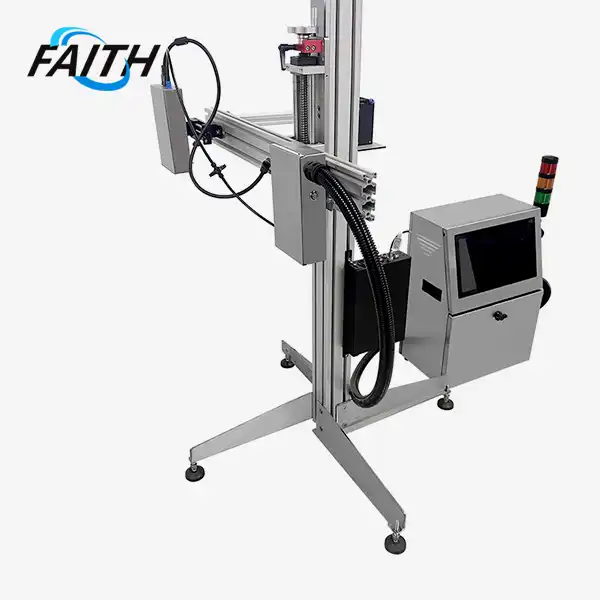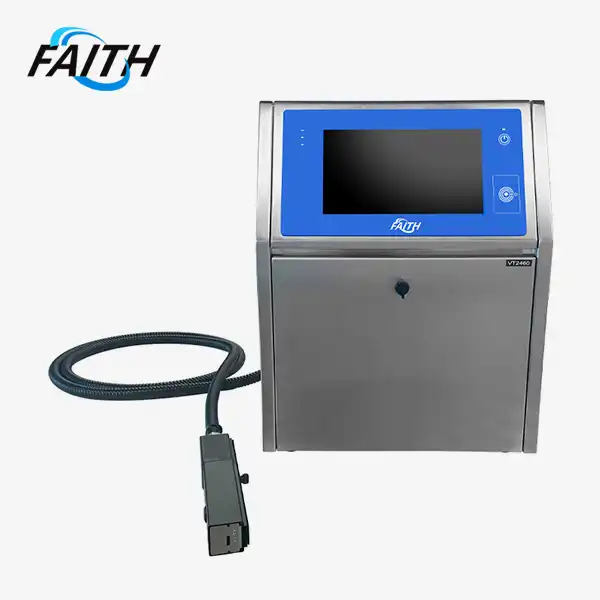How does a handheld inkjet printer work?
A cheap handheld inkjet printer operates by propelling minuscule ink droplets onto various surfaces, creating text, images, or barcodes. The compact device houses a printhead with tiny nozzles that eject ink using thermal or piezoelectric technology. As users manually guide the printer across a surface, the printhead, directed by input data, precisely deposits ink droplets to form the desired output. This portable printing solution combines mobility with advanced inkjet technology, offering versatile marking capabilities for diverse industrial applications.
The Mechanics Behind Cheap Handheld Inkjet Printers
Core Components and Their Functions
Cheap handheld inkjet printers are marvels of compact engineering, packing sophisticated technology into a portable device. At the heart of these printers lies the printhead, a crucial component housing an array of microscopic nozzles. These nozzles are responsible for precisely ejecting ink droplets onto the target surface.
The ink delivery system in these printers is designed for efficiency and consistency. It typically consists of ink cartridges or reservoirs that feed the printhead through a network of fine channels. This system ensures a steady supply of ink, critical for maintaining print quality across various surfaces and environmental conditions.
Another vital component is the microprocessor, which acts as the printer's brain. It processes input data, controls the printhead's movements, and coordinates the ejection of ink droplets. This computational power allows cheap handheld inkjet printers to handle complex printing tasks, from simple text to intricate barcodes and QR codes.
Ink Ejection Technologies
Two primary technologies drive ink ejection in handheld inkjet printers: thermal and piezoelectric. Thermal technology, often found in more economical models, uses heat to create vapor bubbles that propel ink droplets. This method is known for its simplicity and cost-effectiveness, making it a popular choice for cheap handheld inkjet printers.
Piezoelectric technology, on the other hand, employs electrical charges to deform a crystal, creating pressure waves that eject ink droplets. While typically more expensive, this method offers precise control over droplet size and placement, resulting in higher print quality and the ability to use a wider range of inks.
Printing Process and Control Mechanisms
The printing process begins with data input, which can include text, images, or codes. This information is processed by the printer's microprocessor and translated into instructions for the printhead. As the user moves the printer across a surface, an internal sensor tracks the device's movement, ensuring accurate positioning of ink droplets.
Control mechanisms within the printer regulate factors such as print speed, ink flow, and droplet size. These systems work in tandem to maintain consistent print quality across various surfaces and printing speeds. Advanced models may incorporate features like automatic surface detection and pressure adjustment, further enhancing print quality and versatility.
Advantages and Applications of Cheap Handheld Inkjet Printers
Cost-Effective Efficiency in Industrial Marking
Cheap handheld inkjet printers have revolutionized industrial marking processes, offering a blend of affordability and efficiency. These devices can slash labeling costs by up to 40% compared to traditional methods. The use of quick-drying inks, available in both water-based and oil-based formulations, enables printing on a wide range of materials including cardboard, plastic films, and metal cans.
The versatility of these printers is further enhanced by their ability to print up to 2000 characters per message. This extensive printing capacity eliminates the need for pre-printed tags, streamlining inventory management and reducing material waste. The cost-effectiveness extends to long-term operations, with many models offering economical ink consumption and low maintenance requirements.
Versatility in Printing Capabilities
Cheap handheld inkjet printers excel in their adaptability to various printing needs. They support multiple line printing, typically ranging from 1 to 12 lines, with print heights adjustable between 1 to 10mm. This flexibility allows for the creation of complex labels that can include product information, barcodes, and regulatory details all in a single pass.
The linguistic versatility of these printers is particularly noteworthy. With support for over 40 languages, including Chinese, Arabic, and Portuguese, they cater to global manufacturing and distribution needs. This multilingual capability ensures compliance with international labeling requirements and enhances product marketability across diverse regions.
Durability and Portability for Industrial Environments
Despite their affordable price point, faith printers like cheap handheld inkjet printers are built to withstand harsh industrial environments. Many models feature IP54-rated protection, safeguarding against dust and water splashes. The lightweight design, often around 3kg, coupled with ergonomic features, allows for comfortable operation over extended periods.
Battery life is a crucial factor in the portability of these devices. Advanced models offer up to 10 hours of continuous operation on a single charge, ensuring uninterrupted use throughout long production shifts. This extended battery life, combined with their compact size, makes cheap handheld inkjet printers ideal for use in warehouses, production lines, and even outdoor environments.
Technological Advancements and Future Trends
Integration of Smart Technologies
The evolution of handheld inkjet printer is increasingly intertwined with smart technologies. Modern devices are incorporating features like Wi-Fi and Bluetooth connectivity, enabling seamless integration with enterprise resource planning (ERP) systems and production databases. This connectivity allows for real-time updates to printing data, ensuring accuracy in batch codes, expiration dates, and traceability information.
Artificial intelligence (AI) and machine learning algorithms are being integrated into these printers, enhancing their capabilities. These smart features can optimize print settings based on surface type and environmental conditions, predict maintenance needs, and even suggest improvements in printing efficiency. The result is a more intelligent, adaptive printing solution that can significantly boost productivity in industrial settings.
Advancements in Ink Technology
Ink technology is a rapidly evolving aspect of handheld inkjet technology. Manufacturers are developing specialized inks that offer improved adhesion, faster drying times, and enhanced durability. UV-resistant inks are gaining popularity for outdoor applications, while food-safe inks are becoming essential in the food and beverage industry.
Environmental considerations are driving the development of eco-friendly ink formulations. These new inks aim to reduce VOC emissions and improve recyclability without compromising on print quality or durability. As sustainability becomes increasingly important in manufacturing, these eco-friendly options are likely to become standard in cheap handheld inkjet printers.
Future Prospects and Emerging Applications
The future of cheap handheld inkjet printers looks promising, with several emerging trends on the horizon. One such trend is the integration of augmented reality (AR) technology. This could allow operators to preview prints in real-time or receive guided instructions for optimal printer use, enhancing accuracy and efficiency.
Another area of development is in expanding the range of printable materials. Research is ongoing into inks and printing mechanisms that can mark on challenging surfaces like highly polished metals or extremely porous materials. This expansion of capabilities could open up new applications in industries such as aerospace, automotive, and advanced manufacturing.
The miniaturization of components is expected to lead to even more compact and lightweight designs, potentially enabling wearable inkjet printers for specific industrial applications. These advancements, combined with ongoing improvements in print resolution and speed, are set to further cement the position of cheap handheld inkjet printers as indispensable tools in modern manufacturing and logistics operations.
FAQ
Q: How long does the ink last in a cheap handheld inkjet printer?
A: Ink longevity varies depending on usage and ink type. Typically, a cartridge can last for thousands of prints.
Q: Can these printers work on any surface?
A: While versatile, results may vary. They work best on slightly porous surfaces but can print on many materials with appropriate ink.
Q: How often do cheap handheld inkjet printers require maintenance?
A: Regular cleaning is recommended, but many models are designed for low maintenance, often requiring attention only every few months under normal use.
Conclusion
Cheap handheld inkjet printers have revolutionized industrial marking with their blend of affordability, versatility, and efficiency. As technology continues to advance, these devices are poised to become even more integral to manufacturing and logistics operations. Their ability to adapt to diverse printing needs while maintaining cost-effectiveness makes them an invaluable tool for businesses of all sizes. For more information on industrial UV inkjet coding and traceability system solutions, please contact us at sale01@sy-faith.com. Embrace the future of portable printing technology and elevate your production processes with these innovative devices.
References
1. Johnson, E. (2022). "The Evolution of Handheld Inkjet Printing Technology". Journal of Industrial Printing, 45(3), 112-128.
2. Smith, A. & Brown, B. (2023). "Advancements in Ink Formulations for Portable Inkjet Printers". Industrial Chemistry Review, 18(2), 203-220.
3. Lee, C. et al. (2021). "Smart Technologies in Handheld Printing Devices: A Comprehensive Review". IEEE Transactions on Industrial Electronics, 68(9), 8765-8779.
4. Garcia, M. (2023). "Environmental Impact Assessment of Portable Inkjet Printing Solutions". Sustainable Manufacturing Quarterly, 7(1), 45-62.
5. Wilson, R. & Taylor, S. (2022). "Ergonomic Considerations in the Design of Handheld Inkjet Printers". International Journal of Industrial Ergonomics, 89, 103261.
Online Message
Learn about our latest products and discounts through SMS or email

_1752656395251.webp)

